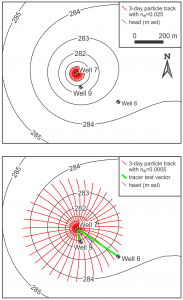
It is often a challenge to choose an appropriate value for effective porosity when using groundwater models to determine travel times in bedrock aquifers. Groundwater models are usually calibrated using water level and permeability measurements, plus data on recharge to and discharge from an aquifer. These models usually work well for flow, but for transport a value for effective porosity is needed. Most flow in bedrock aquifers is usually through fractures and channels, and their porosity is usually 0.00001- 0.01. However, if preferential flow is absent then the total porosity would be used, and total porosity is usually in the range 0.01-0.4. This means that there can be great uncertainty in the effective porosity, which is then carried though to produce great uncertainty in model travel times.
Where travel times have been measured using injected tracers, they often reveal groundwater velocities >>10 m/d, reflecting preferential flow with effective porosities usually being well below 0.01, such as where pathogenic bacteria contaminated the aquifer at Walkerton, Ontario, Canada, as shown in the figure.